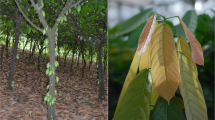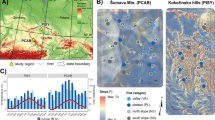Abstract
Species with transcontinental distribution or spread over wide geographical regions develop populations with growth traits genetically adapted to the local climate. The aim of this study was to investigate the ecotypic sensitivity of bud break, a strong adaptive trait, to a changing environment. Six phenological phases of bud break were monitored daily on black spruce [Picea mariana (Mill.) BSP] seedlings submitted to different temperatures (12, 16 and 20 °C) and photoperiods (14, 18 and 22 h). Six provenances were tested in growth chambers, produced from seeds collected along the whole latitudinal range of the closed boreal forest in Quebec, Canada. Bud break lasted 13.3 days on average and occurred earlier in seedlings from colder sites. The annual temperature of the sites suitably tracked the clinal variation among ecotypes, providing a clear biological explanation for the environmental signal driving the adaptive divergence of populations to the local climate. Increasing temperature induced an earlier bud break according to a non-linear pattern with greater advancements observed between 12 and 16 °C. Photoperiod was significant, but sensitivity analysis indicated that its effect on bud break was marginal with respect to temperature. No interaction of provenance × treatment was observed, demonstrating an ecotypic convergence of the responses to both factors. Changes in the growing conditions could substantially modify the synchronization between bud phenology and climate, thus exposing the developing meristems of black spruce to frost damage. However, similar advancements of bud break could be expected in the different ecotypes subjected to warmer temperatures or longer day lengths.



Similar content being viewed by others
References
Basler D, Körner C (2012) Photoperiod sensitivity of bud burst in 14 temperate forest tree species. Agric For Meteorol 165:73–81
Blum BM (1988) Variation in the phenology of bud flushing in white and red spruce. Can J For Res 18:315–319
Boulouf Lugo J, Deslauriers A, Rossi S (2012) Duration of xylogenesis in black spruce lengthened between 1950 and 2010. Ann Bot 110:1099–1108
Caffarra A, Donnelly A (2011) The ecological significance of phenology in four different tree species: effects of light and temperature on bud burst. Int J Biometeorol 55:711–721
Caffarra A, Eccel E (2010) Increasing the robustness of phenological models for Vitis vinifera cv. Chardonnay. Int J Biometeorol 54:255–267
Cariboni J, Gatelli D, Liska R, Saltelli A (2007) The role of sensitivity analysis in ecological modelling. Ecol Model 203:167–182
Chmielewski F-M, Rötzer T (2001) Response of tree phenology to climate change across Europe. Agric For Meteorol 108:101–112
Chuine I (2010) Why does phenology drive species distribution? Philos Trans R Soc Lond Ser B Biol Sci 365:3149–3160
Davis MB, Shaw RG (2001) Range shifts and adaptive responses to Quaternary climate change. Science 292:673–679
Dhont C, Sylvestre P, Gros-Louis M-C, Isabel N (2010) Field guide for identifying apical bud break and bud formation stages in white spruce. Natural Resources Canada, Quebec
Ghelardini L, Falusi M, Santini A (2006) Variation in timing of bud-burst of Ulmus minor clones from different geographical origins. Can J For Res 36:1982–1991
Gould PJ, Harrington CA, St. Clair JB (2011) Incorporating genetic variation into a model of budburst phenology of coast Douglas-fir (Pseudotsuga menziesii var. menziesii). Can J For Res 41:139–150
Hänninen H (2006) Climate warming and the risk of frost damage to boreal forest trees: identification of critical ecophysiological traits. Tree Physiol 26:889–898
Huang J-G, Deslauriers A, Rossi S (2014) Xylem formation can be modeled statistically as a function of primary growth and cambium activity. New Phytol 203:831–41
Ibáñez I et al (2010) Forecasting phenology under global warming. Philos Trans R Soc Lond Ser B Biol Sci 365:3247–3260
IPCC (2013) Climate change 2013: the physical science basis. Contribution of working group I to the fifth assessment report of the intergovernmental panel on climate change. Cambridge University Press, Cambridge
Khalil MAK (1975) Genetic variation in black spruce (Picea mariana (Mill.) B.S.P) in Newfoundland. Silva Genet 24:88–96
Körner C (2003) Alpine plant life: functional plant ecology of high mountain ecosystems. Springer-Verlag, Berlin
Körner C (2012) Alpine treelines - functional ecology of the global high elevation tree limits. Springer, Basel
Körner C, Basler D (2010) Phenology under global warming. Science 327:1461–1462
Laube J, Sparks TH, Estrella N, Höfler J, Ankerst DP, Menzel A (2013) Chilling outweights photoperiod in preventing precocious spring development. Glob Chang Biol 20:170–182
Li P, Beaulieu J, Corriveau A, Bousquet J (1993) Genetic variation in juvenile growth and phenology in a white spruce provenance-progeny test. Silva Genet 42:52–60
Lu P, Man R (2011) Assessment of assisted migration effects on spring bud flush in white spruce (Picea glauca [Moench] Voss) seedlings. Forest Chron 87:391–397
Man R, Lu P (2010) Effects of thermal model and base temperature on estimates of thermal time to bud break in white spruce seedlings. Can J For Res 40:1815–1820
Menzel A et al (2006) European phenological response to climate change matches the warming pattern. Glob Change Biol 12:1969–1976
Mimura M, Aitken SN (2007) Adaptive gradients and isolation-by-distance with postglacial migration in Picea sitchensis. Heredity 99:224–232
Morecroft MD, Stokes VJ, Morison JIL (2003) Seasonal changes in the photosynthetic capacity of canopy oak (Quercus robur) leaves: the impact of slow development on annual carbon uptake. Int J Biometeorol 47:221–226
Morin X, Lechowicz MJ, Augspurger C, O’Keefe J, Viner D, Chuine I (2009) Leaf phenology in 22 North American tree species during the 21st century. Glob Change Biol 15:961–975
Morin X, Roy J, Sonié L, Chuine I (2010) Changes in leaf phenology of three European oak species in response to experimental climate change. New Phytol 186:900–910
Pallardy SG (2008) Physiology of woody plants. Academic, London
Partanen J, Leinonen I, Repo T (2001) Effect of accumulated duration of the light period on bud burst in Norway spruce (Picea abies) of varying ages. Silva Fenn 35:111–117
Picard G, Quegan S, Delbart N, Lomas MR, Le Toan T, Woodward FI (2005) Bud-burst modelling in Siberia and its impact on quantifying the carbon budget. Glob Change Biol 11:2164–2176. doi:10.1111/j.1365-2486.2005.01055.x
Plummer DA et al (2006) Climate and climate change over North America as simulated by the Canadian RCM. J Clim 19:3112–3132
Régnière J, St-Amant R (2007) Stochastic simulation of daily air temperature and precipitation from monthly normals in North America north of Mexico. Int J Biometeorol 51:415–430
Rossi S, Deslauriers A, Anfodillo T, Carrer M (2008a) Age-dependent xylogenesis in timberline conifers. New Phytol 177:199–208
Rossi S et al (2008b) Critical temperatures for xylogenesis in conifers of cold climates. Glob Ecol Biogeogr 17:696–707
Rossi S, Tremblay M-J, Morin H, Levasseur V (2009) Stand structure and dynamics of Picea mariana on the northern border of the natural closed boreal forest in Quebec, Canada. Can J For Res 39:2307–2318
Rossi S, Morin H, Deslauriers A (2011) Multi-scale influence of snowmelt on xylogenesis of black spruce. Arct Antarct Alp Res 43:457–464
Rossi S, Morin H, Gionest F, Laprise D (2013) Spatially explicit structure of natural stands dominated by black spruce. Silva Fenn 47:973
Rossi S, Girard M-J, Morin H (2014) Lengthening of the duration of xylogenesis engenders disproportionate increases in xylem production. Glob Change Biol 20:2261–2271
Savolainen O, Pyhäjärvi T, Knürr T (2007) Gene flow and local adaptation in trees. Annu Rev Ecol Evol Syst 38:595–619
Schleip C, Menzel A, Dose V (2008) Norway spruce (Picea abies): Bayesian analysis of the relationship between temperature and bud burst. Agric For Meteorol 148:631–643
Simard M, Payette S (2005) Reduction of black spruce seed bank by spruce budworm infestation compromises postfire stand regeneration. Can J For Res 35:1686–1696
Sirois L (2000) Spatiotemporal variation in black spruce cone and seed crops along a boreal forest - tree line transect. Can J For Res 30:900–909
Søgaard G, Johnsen Ø, Nilsen J, Junttila O (2008) Climatic control of bud burst in young seedlings of nine provenances of Norway spruce. Tree Physiol 28:311–320
Sonnentag O et al (2012) Digital repeat photography for phenological research in forest ecosystems. Agric For Meteorol 152:159–177
Sparks TH, Jeffree EP, Jeffree CE (2000) An examination of the relationship between flowering times and temperature at the national scale using long-term phenological records from the UK. Int J Biometeorol 44:82–87
Thomson JD (2010) Flowering phenology, fruiting success and progressive deterioration of pollination in an early-flowering geophyte. Philos Trans R Soc Lond Ser B Biol Sci 365:3187–3199. doi:10.1098/rstb.2010.0115
Wang Y, Li X, Dawadi B, Eckstein D, Liang E (2013) Phenological variation in height growth and needle unfolding of Smith fir along an altitudinal gradient on the southeastern Tibetan Plateau. Trees 27:401–407
White MA et al (2009) Intercomparison, interpretation, and assessment of spring phenology in North America estimated from remote sensing for 1982 to 2006. Glob Change Biol 15:2335–2359
Yu H, Luedeling E, Xu J (2010) Winter and spring warming result in delayed spring phenology on the Tibetan Plateau. Proc Natl Acad Sci U S A 107:22151–22156
Acknowledgments
This work was funded by grants from Forêt d’Enseignement et de Recherche Simoncouche, Consortium de Recherche sur la Forêt Boréale Commerciale, Fonds de Recherche sur la Nature et les Technologies du Québec, National Sciences and Engineering Research Council of Canada and Canada Foundation for Innovation. The author thanks I. Allie, L. Balducci, C. Boivin, M.-J. Deschenes, D. Gagnon and C. Soucy for technical support and A. Garside for editing the English text.
Author information
Authors and Affiliations
Corresponding author
Rights and permissions
About this article
Cite this article
Rossi, S. Local adaptations and climate change: converging sensitivity of bud break in black spruce provenances. Int J Biometeorol 59, 827–835 (2015). https://doi.org/10.1007/s00484-014-0900-y
Received:
Revised:
Accepted:
Published:
Issue Date:
DOI: https://doi.org/10.1007/s00484-014-0900-y




